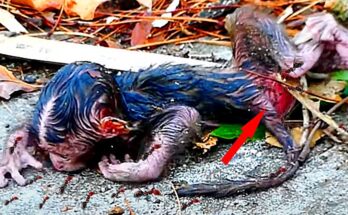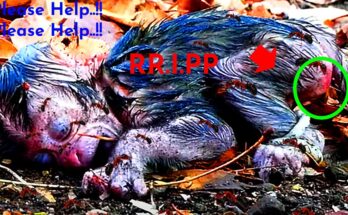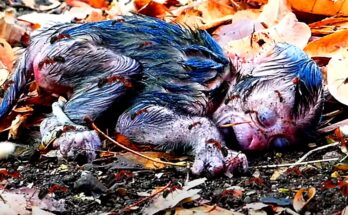🐒 Life of Long-Tailed Monkeys in the Wild
Habitat and Range
Long-tailed macaques live across much of Southeast Asia — Thailand, Cambodia, Malaysia, Indonesia, and the Philippines. They prefer tropical forests near rivers or coasts but have also adapted well to living close to villages and cities.
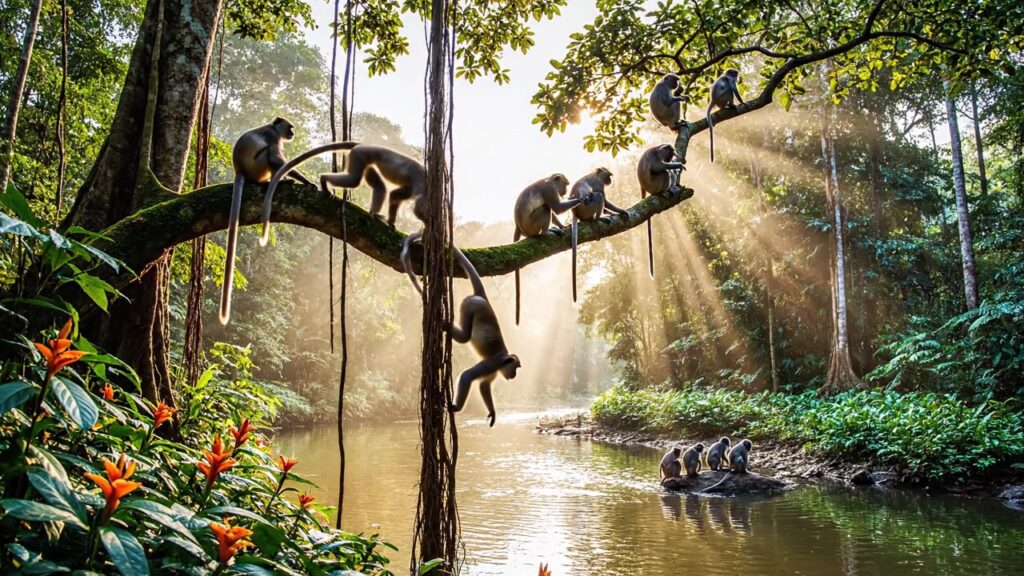
🧬 Reproduction and Birth
Female long-tailed macaques usually become sexually mature around 4 to 5 years old.
They can breed year-round, but in many areas, most births happen at the start of the rainy season when food is abundant.
- Pregnancy lasts about 5½ to 6 months.
- Number of babies: usually one infant per birth, twins are rare.
- A female may give birth once every 1½ to 2 years, depending on how well she can care for the last baby.
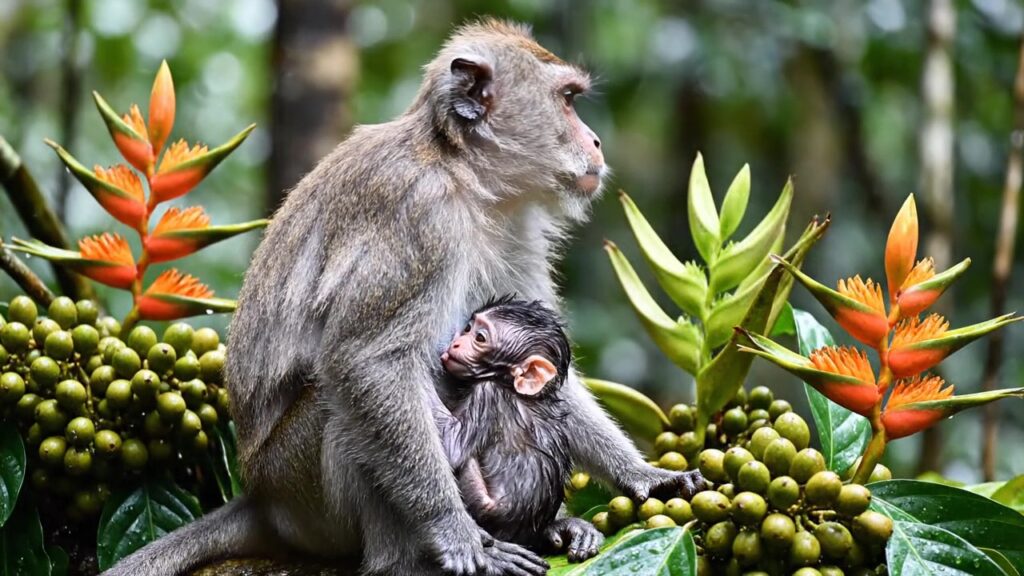
👩🍼 Raising the Young
Newborn macaques cling tightly to their mother’s belly for the first few months.
The mother nurses and protects her infant, carrying it everywhere. As the baby grows, it begins to explore, play, and learn social rules by watching older monkeys.
Mothers are usually very protective — but in some cases, a first-time mother may not know how to handle her infant. She might neglect it, carry it improperly, or even abandon it. This happens mostly with young or stressed females who haven’t learned parenting behavior from observing others in the troop.
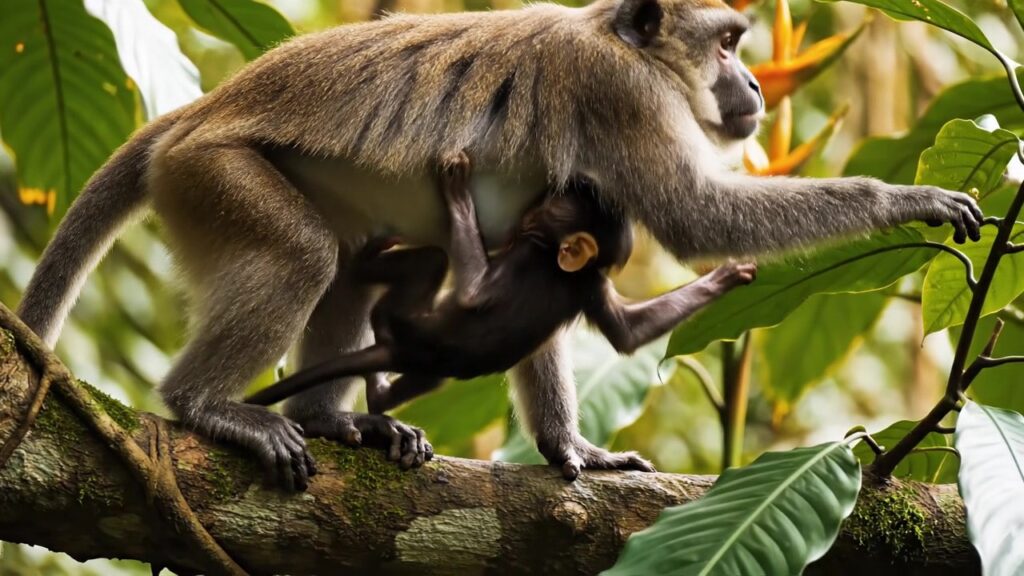
🦍 Role of the Male
In macaque groups, males don’t usually act as “fathers” to one specific baby, since paternity isn’t clear. But the dominant male — the leader of the troop — plays an important role.
He defends the group from predators, rival males, and other dangers. During conflicts, he stands between the females and threats. His strength keeps the troop stable.
Sometimes, lower-ranking males may show gentle behavior toward infants, grooming or guarding them, but it’s rare for a male to take on full parental care.
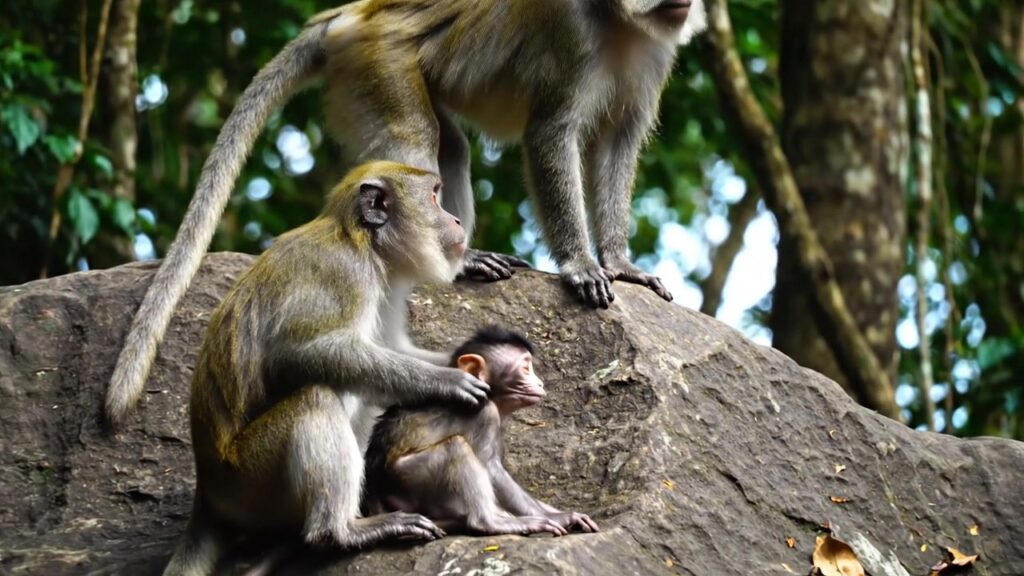
💔 Infanticide and Aggression
While mothers are the main caregivers, aggression toward infants can happen in macaque society. A stressed or inexperienced mother might reject or harm her own baby. Rival females or males sometimes attack infants, especially if a new dominant male takes over — this behavior (infanticide) forces females to become fertile again sooner.
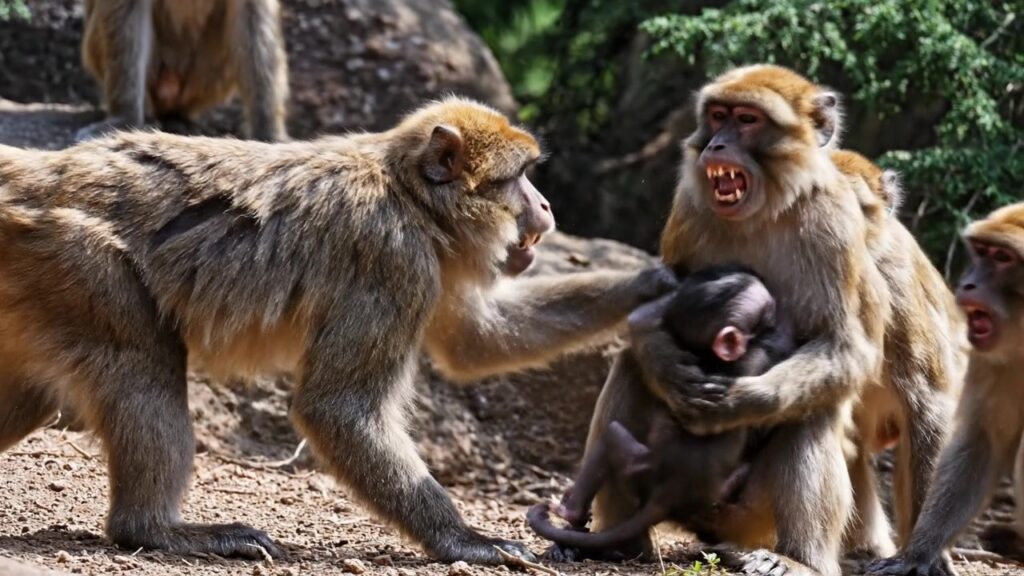
🌳 Summary
- Species: Long-tailed macaque (Macaca fascicularis)
- Habitat: Forests, mangroves, temples, and urban areas in Southeast Asia
- Gestation: ~6 months
- Offspring: 1 baby every 1.5–2 years
- Caregiver: Mainly the mother
- Group life: Led by dominant male, with strong female bonds
- Challenges: Young mothers may neglect babies; group conflicts can threaten infants
The emerald canopy hummed with the symphony of a thousand unseen lives, a vibrant tapestry woven above the murky, life-giving waters of a Southeast Asian river. Here, where mangrove roots snaked like ancient veins into the brackish earth, and the air hung thick with the scent of salt and decaying leaves, lived the riverine clan of long-tailed macaques (Macaca fascicularis).
They were a common sight, these adaptable primates, their slender bodies, grizzled grey fur, and famously long tails—often longer than their bodies—defining their agile movements through the dense foliage. But to observer Dr. Aris Puth, who had dedicated two decades to their study, they were anything but common. Each member of the ‘River’ troop, as he called them, was a distinct personality, navigating a complex social web of alliances, rivalries, and an unyielding drive to survive.
At the heart of the River troop’s stability was Kala, a male of formidable presence. His face, etched with the scars of countless skirmishes, bore the weight of his dominance. He was the alpha, the ‘main father’ in all but biological terms for many of the young, his primary role being the unwavering protector of his sixty-strong extended family. His deep, resonant calls were the first warning of danger, his imposing figure the last line of defence.
Chapter 1: The Emerald Canopy and the Riverine Clan
The morning sun dappled through the dense foliage, painting shifting patterns on the forest floor as the River troop began their day. Their habitat, a labyrinth of interconnected waterways and coastal forests, provided an abundance of food: crabs from the mudflats, fruits from the trees, insects, and even small vertebrates. They were opportunistic and clever, masters of their domain.
Kala, observing from a high branch, watched as the troop dispersed. Youngsters chased each other through the undergrowth, their playful squeals echoing through the trees. Females groomed one another, meticulously picking through fur, strengthening social bonds with every careful stroke. Sub-adult males engaged in mock fights, testing their strength and establishing their place in the hierarchy, always careful not to provoke Kala’s watchful gaze.
Among the younger females was Sita, barely three years old, her fur still holding a youthful sheen. This was her first time truly joining the reproductive cycle of the troop. She was an energetic, somewhat flighty macaque, more prone to chasing butterflies than settling down for a quiet grooming session. Dr. Puth had noted her a year ago, tracking her transition from a rambunctious juvenile to a maturing female, her body now undergoing the subtle changes that signaled her readiness to conceive.
The troop’s rhythm was dictated by the seasons, and the current period marked the peak of their mating activity. Males, including Kala and the ambitious Beta male, Rian, displayed for the females, posturing, chattering, and vying for attention. Females, when receptive, presented themselves, initiating the brief, intense encounters that would determine the future of the troop.
Sita, despite her youthful exuberance, found herself drawn into this ancient dance. She was often seen near Rian, a sleek, powerful male second only to Kala, whose charisma was undeniable. Dr. Puth observed their interactions through his binoculars, noting the subtle cues: Sita’s glances, Rian’s exaggerated displays. It was a natural progression, a cycle as old as the river itself.
Chapter 2: Cycles of Life and New Beginnings
Six months later, the troop was once again alive with new life. Long-tailed macaques typically have a gestation period of around 160-170 days, resulting in a single birth. While twins are rare, a healthy female usually gives birth once a year, or every other year, depending on her physical condition and the availability of resources. This year, the troop had been particularly successful, with five new infants clinging to their mothers’ bellies, their tiny fingers gripping fur as if their lives depended on it – which, in essence, they did.
Sita, however, had been conspicuously absent from the communal infant huddle. For days, she had been withdrawn, seeking solitude in the denser parts of the forest, a typical behavior for a female preparing to give birth. Dr. Puth had kept a respectful distance, knowing that intervention, even observation, could be stressful.
Then, one morning, a new, tiny cry pierced the usual forest sounds. Sita emerged from the shadows, her usually slender frame now somewhat awkward, a tiny, dark-furred bundle clinging precariously to her underside. It was a female, small and fragile, with wide, curious eyes. Dr. Puth named her Kiki, a nod to her initial, hesitant squeaks.
The troop gathered around, a mix of curiosity and protective instinct. Experienced mothers gently sniffed at the newborn, their own infants clinging tightly, perhaps sensing the novelty of a new addition. Kala, after a brief, assessing glance, moved on, trusting the natural order. His role was broader, encompassing the safety of the entire troop, not individual mother-infant bonds unless a serious threat arose.
Sita, however, seemed different. While she allowed Kiki to nurse, her movements were stiff, almost reluctant. She didn’t perform the constant, meticulous grooming typical of a new mother. Her gaze often seemed distant, not focused on the vulnerable creature clinging to her. It was subtle at first, easily dismissed as the awkwardness of a first-time mother. After all, maternal instincts, though often innate, also require learning and practice, especially in a social context.
Chapter 3: The Shadow of Rejection
As the days turned into a week, Dr. Puth grew increasingly concerned. Kiki, though nursing, seemed less robust than the other infants. Her cries were more frequent, often ignored by Sita, who would simply shift her weight or turn away. Grooming, crucial for hygiene and bonding, was minimal. The bond, so palpable between other mothers and their newborns, seemed tenuous, almost fragile, with Sita and Kiki.
Dr. Puth had witnessed instances of maternal rejection before. Sometimes, a first-time mother, overwhelmed by the responsibility, simply lacked the necessary instinct. Other times, an infant might be born with an imperceptible defect, causing the mother to instinctively reject it to conserve resources. Stress, inadequate nutrition, or even an unnatural event could trigger such a devastating outcome.
Sita’s behavior escalated. She began to actively push Kiki away when the infant sought to nurse. Her patience, if it had ever truly existed, wore thin. Kiki’s tiny cries became desperate, heart-wrenching pleas for warmth and sustenance. The other females in the troop, usually quick to offer comfort or curiosity, began to look at Sita with a mixture of confusion and concern. Some would approach Kiki, gently touch her, but none dared to fully intervene while Sita was still present.
One humid afternoon, the inevitable happened. Sita, agitated and restless, began to move through the canopy at a faster pace than usual. Kiki, struggling to maintain her grip, whimpered. Suddenly, with a sharp, almost deliberate twitch, Sita dislodged her. Kiki fell, not far, perhaps only a meter, landing with a soft thud on a low-hanging branch. She cried out, a terrified sound that tore through the relative quiet of the forest.
Sita glanced back, a flicker of something unreadable in her eyes – perhaps fear, perhaps indifference – then continued moving. She did not return. Kiki was alone, vulnerable, abandoned. The other macaques froze, their chattering silenced, witnessing the brutal truth of nature’s indifference.
Chapter 4: A Mother’s Heart, A Troop’s Compassion
Kiki’s cries continued, a tiny beacon of distress in the vast forest. She lay curled on the branch, shivering, her eyes wide with terror and confusion. Dr. Puth, watching from a hidden vantage point, felt a familiar ache of helplessness. He knew the strict ethics of non-intervention, the harsh reality that some simply don’t make it in the wild. But Kiki’s plight was particularly poignant.
Hours passed. The sun began its slow descent. Kiki, exhausted, had ceased her louder wails, instead emitting soft, whimpering sounds. Then, a shadow detached itself from the troop. It was Maya, an older, experienced female, herself nursing a robust two-month-old infant. Maya was known for her calm demeanor and her gentle nature. She approached Kiki cautiously, sniffing at the abandoned infant, then looked towards Sita, who was now foraging several trees away, seemingly oblivious.
Slowly, carefully, Maya extended a hand and gently, almost hesitantly, pulled Kiki towards her. Kiki, sensing warmth, instinctively latched onto Maya’s fur, her small body trembling. Maya groomed her for a moment, a swift, practiced motion, then, with a decision that seemed both spontaneous and deeply ingrained, she adjusted her own infant on her chest and allowed Kiki to cling to her back.
This act, known as alloparenting, was not uncommon in macaque troops, but usually involved younger, eager females ‘babysitting’ for short periods. For an experienced mother to adopt a completely abandoned infant was a rarer, more significant gesture. Maya now had two infants to care for, a double burden that would test her resources and endurance. Her own infant, Leo, seemed to accept Kiki’s presence with mild curiosity, occasionally nudging the newcomer with a tiny hand.
Maya, however, could not produce milk for Kiki. The little macaque would have to rely on scraps of food Maya might drop, or learn to forage exceptionally early. Maya offered comfort, grooming, and protection, keeping Kiki close. She taught Kiki how to navigate the branches, how to identify safe foods, but the direct maternal nursing and bonding that was vital for such a young infant was missing. Kiki remained small, a perpetual shadow compared to Leo and the other infants, but she clung to life with a fierce, unwavering tenacity.
Chapter 5: Kala’s Vigilance – The Protector’s Burden
While Maya’s compassion offered Kiki a fragile lifeline, the troop’s ultimate survival, and thus Kiki’s continued chance, lay squarely on Kala’s broad shoulders. His protection wasn’t about individual care, but about ensuring the safety of the collective.
One afternoon, the serene calm of the mangroves was shattered by an urgent, piercing alarm call from a vigilant sentry. A rival troop, larger and more aggressive, had encroached upon the River clan’s territory. These clashes were brutal, often resulting in injuries or even deaths, and threatened the very cohesion of the troop.
Kala was instantly transformed. His calm demeanor evaporated, replaced by a fierce, primal intensity. With a deafening roar, he launched himself towards the invading macaques, followed closely by Rian and the other adult males. It was a chaotic ballet of teeth and claws, a deafening cacophony of shrieks and growls. Kala, a veteran of countless such battles, fought with a calculated ferocity, targeting the rival alpha male, his movements a blur of power and precision.
The females and youngsters, including Maya with her two charges, huddled together, their eyes wide with fear, clinging to the highest, safest branches. Kiki, tucked tightly against Maya’s back, trembled violently, burying her face in the older female’s fur. The air vibrated with the raw energy of the confrontation.
After a tense, brutal fifteen minutes, Kala, with a final, dominant lunge, drove the rival alpha back. The invaders, demoralized and outmaneuvered by Kala’s tactical genius and the unified front of his males, began to retreat, melting back into the dense undergrowth from which they had emerged.
Kala returned to his troop, panting, a fresh gash on his shoulder, but his posture radiating an undeniable triumph. He didn’t seek praise or comfort. Instead, he simply surveyed his troop, his gaze sweeping over each member, a silent affirmation of his successful protection. In his vigilance, in his willingness to lay down his life for the troop, he had ensured that Kiki, Maya, Leo, and every other macaque had another day to forage, to play, to simply be. Without Kala, there would be no River troop, no chance for Kiki to find even her tenuous place.
Later that evening, as the troop settled into their sleeping trees, Kala moved among them, his presence a comforting anchor. He paused briefly near Maya, glancing at the two infants clinging to her. For a fleeting moment, his eyes met Kiki’s. He didn’t groom her, didn’t offer direct comfort, but his silent acknowledgment, his very presence, was a profound act of protection for the smallest, most vulnerable member of his clan.
Chapter 6: Echoes of the Wild
Months turned into a year, then two. Kiki, though still smaller than her age-mates, had thrived under Maya’s unconventional care. She had learned to forage efficiently, to be alert, and to navigate the complex social dynamics of the troop. She was independent, resilient, a testament to Maya’s compassion and her own indomitable spirit. She often played with Leo, forming a unique bond with her adoptive brother. While she would always carry the faint scar of her early abandonment, she was undeniably a member of the River troop.
Sita, after Kiki’s rejection, had gone through another estrus cycle. This time, when she gave birth, she was different. Perhaps it was the learning experience of her first failed attempt, perhaps a shift in her own internal wiring, but her second infant, a robust male, received all the care and attention that Kiki had been denied. Sita meticulously groomed him, nursed him with unwavering dedication, and protected him with fierce maternal instinct. Dr. Puth observed, a silent witness to the complexities of natural selection and the capacity for growth, even in the wild.
Kala continued his reign, a silent, powerful force shaping the destiny of the River troop. His vigilance ensured their safety from predators like pythons and monitor lizards, from rival troops, and from the increasing encroachment of human settlements. He was the anchor, the unyielding protector, a living embodiment of the troop’s resilience.
The life of the long-tailed macaque, Dr. Puth reflected, was a delicate balance of beauty and brutality, of instinct and learned behavior, of individual struggle and communal support. It was a story told in the rustling leaves, the splashing water, and the complex interactions of a troop under the watchful eye of its alpha. From the joy of new births, through the heartbreak of rejection, to the unwavering protection of a dominant male, the riverine clan continued its ancient dance, an enduring echo of the wild in an ever-changing world. And Kiki, the once-abandoned infant, now a spirited juvenile, was a living testament to its profound, unpredictable, and ultimately, compelling narrative.
